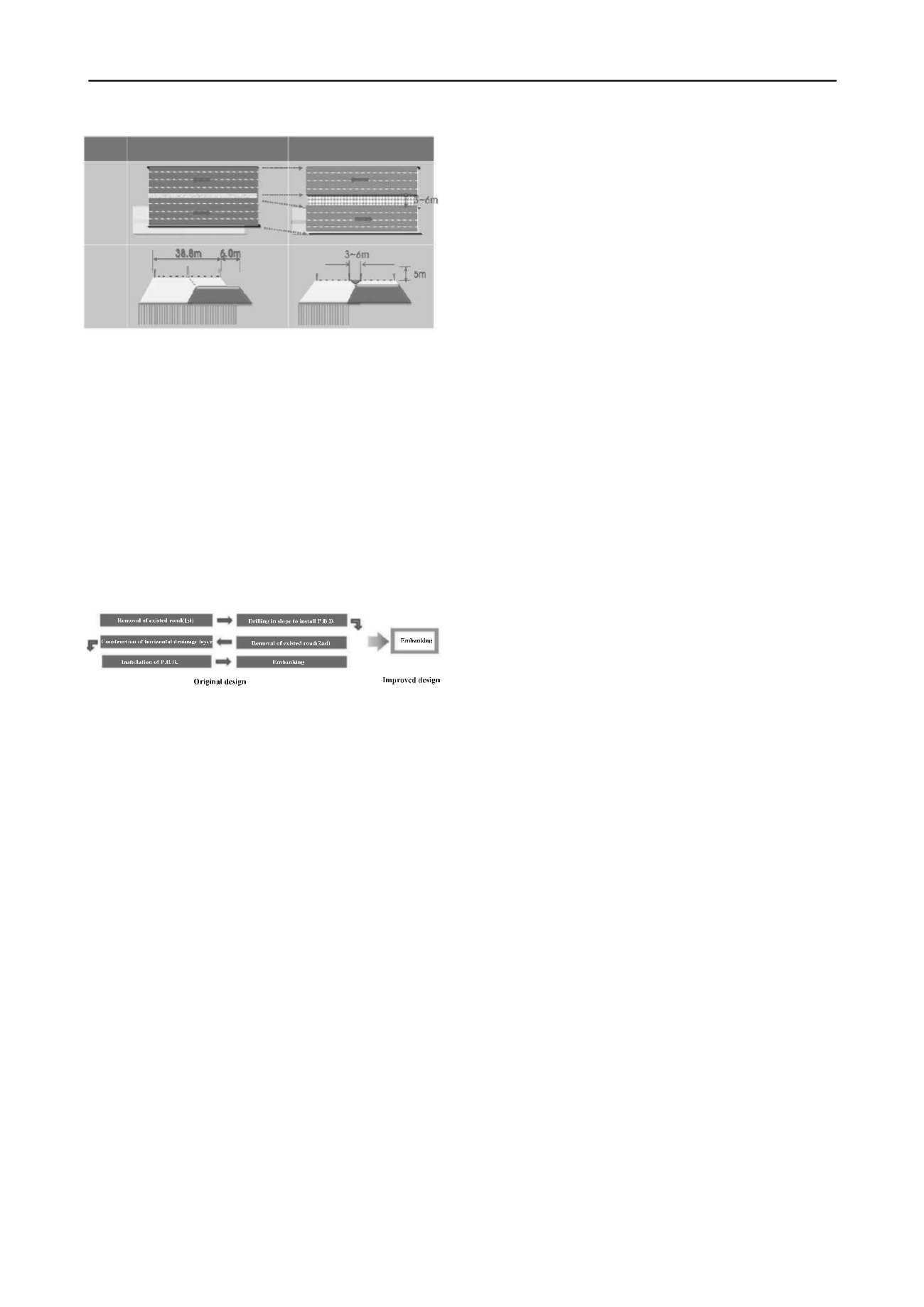
2956
Proceedings of the 18
th
International Conference on Soil Mechanics and Geotechnical Engineering, Paris 2013
Figure 5. A plan for the road separation.
5.3
Feasibility of improvement factors
5.3.1 Constructability aspect
Reducing the number of construction steps from six to one
makes it possible to reduce the time required for construction by
more than 10 months. This reduction in construction time
offsets the delays due to land purchases, civil complaints, etc. at
the initial stage of this project.
The improved plan does not require disposal of soils and
pavement materials removed from the existing road. The
constructability would be improved because the sequence of
work activities is not limited and issues such as the difficulty of
PBD installation by drilling on the slope of existing road can be
avoided.
Figure 6. Simplification of construction phases.
5.3.2 Economic aspects
If PBD is installed in the soil of the existing road, additional
expense is involved in drilling or removing the gravel and
crushed stone underneath the existing road. In addition, a cost
for disposal of the asphalt concrete is also incurred. However,
the improved plan would result in a decreased net volume of the
embankment and length of drainage material and consequently a
decrease in the construction cost.
5.3.3 Stability aspects
If PBD is installed to improve the soil under the existing road, it
is expected that a coupled settlement will occur near adjacent
roads, railways, farmland, facilities, and other structures due to
the soil settlement. The improved plan does not involve
improvement of the soft soil of the existing road and
consequently protects the stability of structures located near the
existing road.
6 CONCLUSIONS
This study was conducted to develop improved design and
construction methods for expansion of a roadway on a deep
layer of soft soil. The project that was the focus of this study
was the expansion of the second branch of the Namhae
Expressway. The original design plans were reviewed, problems
were discussed and solutions for the problems were proposed.
With the improved plan, it does not necessary to dispose of
soil and asphalt concrete removed from the existing road. The
constructability of the project would be improved because the
sequence of work activities is simplified and issues related to
the difficulty of installing PBD by drilling on the slope of the
existing road can be avoided.
The improved plan reduces the construction cost. Installation
of PBD beneath the existing road would involve additional costs
for drilling or removing gravel and crushed stone underneath
the existing road. In addition, there would be a cost for disposal
of the waste asphalt concrete.
If PBD is used to improve the soil under the existing road, it
is expected that coupled settlement will occur near adjacent
structures due to the soil settlement. The improved plan does
not involve improvement of the soft soil of the existing road and
consequently protects the stability of structures located near the
existing road.
7 ACKNOWLEDGEMENTS
This study was performed with the support and cooperation of
the Naengjeong
–
Busan Construction Agency of the Korea
Expressway Corporation.
8 REFERENCES
Cheong H.-I., Lee Y.-S., Cheong G.-S., Jin H.-S., Cheong M.-G., Woo
J.-Y., Cho S.-D., Kim Y.-J., Ahn T.-B., Kim I.-D., Koh G.-S. and
Park Y.-M. 1999.
A study of the consolidation characteristics of
soft ground
Cheong J.-H., Cho S.-M., Kim H.-J., Cheong G.-J., Park J.-G. and Kim
D.-S. 2005. A study of the settlement evaluation and maintenance
of long-term settlement for the highway on the soft grounds.
Expressway & Transportation Research Institute
Choi Y.-C., Cheon S.-S., Park Y.-S. and Yang H.-S. 2003, A Study of
Compaction Density of Surcharge on Soft Ground. Expressway &
Transportation Research Institute, pp.200
Kim H.-J., Cho S.-M., Cheong J.-H., Cheong G.-J., Soe J.-W. and Lee
J.-Y. 2004. Countermeasures for maintenance of highway on soft
ground (
Ⅱ
). Expressway & Transportation Research Institute, pp.46
Kim S.-H. and Noh H.-S. 1995. A study on the settlement estimation of
soft ground. Expressway & Transportation Research Institute,
pp.300
Korea Expressway Corporation. 1982. Documents for Busan~Masan
Expressway Construction
Korea Expressway Corporation. 2002. Road design manual
Korea Expressway Corporation. 2008a. General report for the expansion
project between Naengjeong and Busan of Highway No. 104 in the
Namhae Expressway: Section No.3-1
Korea Expressway Corporation. 2008b. General Report for the
Expansion Project between Naengjeong and Busan of Highway
No. 104 in Namhae Expressway: Section No.3-2
Korea Expressway Corporation. 2008c. The Expansion Project between
Naengjeong and Busan of Highway No. 104 in Namhae
Expressway: Section No.4
Korea Expressway Corporation. 2008d. Ground Survey Report for the
Expansion Project between Naengjeong and Busan of Highway
No. 104 in Namhae Expressway: Section No.3-1
Korea Expressway Corporation. 2008e. Ground Survey Report for the
Expansion Project between Naengjeong and Busan of Highway
No. 104 in Namhae Expressway: Section No.3-2
Korea Expressway Corporation. 2008f. Ground Survey Report for the
Expansion Project between Naengjeong and Busan of Highway
No. 104 in Namhae Expressway: Section No.4
Korea Expressway Corporation. 2008g. Completion Documents for
Pavement Rehabilitation Construction in Gyeongnam Branch(1996
~ 2008.
Korea Land Corporation. 1992. Study on Settlement Measurement in
Soft Ground Improvement (I)
Korean Geotechnical Society. 2005. Soft Ground
Ministry of Construction and Transportation. 2003. Manual and
Guideline for Standards of Road's Structure and Facilities
Ministry of Land, Transport and Maritime Affairs. 1991. Handbook for
Road Pavement Maintenance
Classification
Plane
Cross
section
Original design
Improved design
The existing
road
The existing
road


